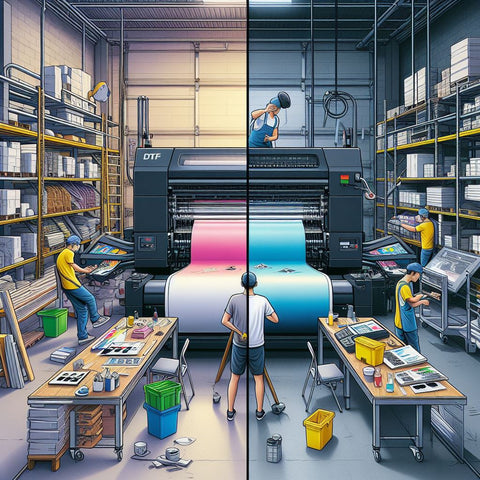In the world of custom t-shirts, DTF transfers have gained immense popularity due to their versatility and high-quality prints. DTF, or Direct to Film, is a printing technique that allows vibrant and detailed designs to be transferred onto garments. However, like any other printing method, working with DTF transfers requires precision and careful attention to detail. In this article, we will discuss some common mistakes to avoid when working with DTF transfers, ensuring that your custom t-shirts turn out flawlessly every time.
Common DTF Transfer Mistakes
1. Neglecting Proper File Preparation
One of the most common mistakes made when working with DTF transfers is failing to prepare the design files correctly. To achieve the best results, it is crucial to ensure that your design has the appropriate resolution, size, and color mode. Low-resolution images can lead to pixelated and blurry prints, while incorrect sizing can result in distorted or disproportionate designs. Additionally, using the wrong color mode may affect the vibrancy and accuracy of your DTF prints.
2. Skipping Pre-Treatment Process
Another grave error is skipping the pre-treatment process. Pre-treatment involves applying a specialized liquid solution onto the garment before printing to enhance the transfer's adhesion and color vibrancy. Neglecting this crucial step can lead to poor adhesion, fading prints, or even complete transfer failure. Ensure that you thoroughly pre-treat your garments before applying DTF transfers to achieve the best possible results.
3. Inadequate Heat Press Settings
To achieve optimal DTF printing results, it is essential to set the correct temperature, pressure, and time on your heat press machine. Inadequate heat press settings can result in incomplete transfers, uneven color distribution, or scorching of the garment. It is recommended to consult the instructions provided by the DTF transfer manufacturer and perform test prints to determine the ideal heat press settings for your specific application.
4. Neglecting Proper Storage
Proper storage of DTF transfers and treated garments is often overlooked but plays a crucial role in maintaining their quality and durability. Exposure to sunlight, heat, or moisture can negatively impact the adhesive properties of DTF transfers, making them less effective during the printing process. Similarly, storing treated garments in humid or damp environments may lead to mold or mildew formation, jeopardizing the overall quality of the prints. Ensure that you store DTF transfers and treated garments in a cool, dry place to preserve their effectiveness.
5. Rushing the Curing Process
The curing process is vital for ensuring the longevity and washability of DTF prints. Rushing the curing process can result in prints that fade or peel after just a few washes. It is essential to follow the recommended curing time and temperature provided by the DTF transfer manufacturer. This will allow the ink in the transfer to properly bond with the garment fibers, ensuring a durable and long-lasting print.
6. Failure to Test Print
Before printing a large batch of custom t-shirts, it is crucial to perform test prints to check the quality, color accuracy, and overall appearance of the DTF transfers. This step allows you to identify any potential issues and make adjustments before proceeding with the final production. Test printing can help you avoid costly mistakes and ensure that your finished products meet your customers' expectations.
7. Not Using a Sticky Mask
When working with DTF transfers, using a sticky mask is highly recommended. A sticky mask is a transparent film that adheres to the printed design, allowing for easy transfer onto the garment. Neglecting to use a sticky mask can make the transfer process more challenging, leading to misalignment, smudging, or distortion of the design. Applying a sticky mask ensures a smooth and precise transfer, resulting in professional-looking custom t-shirts.
8. Overloading the Heat Press
When working with DTF transfers, using too many layers or overloading the heat press can negatively affect the quality of the prints. The excessive pressure applied during the transfer process can lead to incomplete transfers, loss of fine details, or even damage to the garment. It is crucial to follow the manufacturer's recommendations regarding the maximum number of layers and the appropriate amount of pressure to ensure optimal results.
9. Using Incompatible Fabrics
DTF transfers work exceptionally well on certain fabric types, such as cotton or polyester blends. However, they may not adhere properly to fabrics with low heat tolerance or high synthetic content. Before attempting to print on a specific fabric, it is essential to verify its compatibility with DTF transfers. Working with incompatible fabrics may result in transfers that do not fully stick, peel off after washing, or appear faded.
10. Inaccurate Placement of Design
Ensuring accurate placement of the design is crucial in achieving a professional-looking custom t-shirt. Failing to position the design correctly can lead to uneven prints, crooked images, or poor overall aesthetics. Take the time to precisely align and center the design on the garment before applying the DTF transfer. This attention to detail will result in visually pleasing and high-quality prints.
11. Ignoring Post-Printing Guidelines
Post-printing guidelines provided by DTF transfer manufacturers should not be ignored. These guidelines often include recommendations for washing the garments, such as using cold water and avoiding harsh detergents or bleach. Ignoring these guidelines can diminish the overall quality and durability of the DTF prints, leading to premature fading or deterioration.
12. Lack of Proper Maintenance
Lastly, failing to maintain your DTF printing equipment can result in subpar prints and unnecessary downtime. Regularly clean and maintain your heat press machine and DTF printer according to the manufacturer's recommendations. Additionally, store your DTF transfers and other printing supplies in a clean and organized manner. By ensuring proper maintenance, you can prolong the lifespan of your equipment and consistently produce high-quality DTF prints.
Driven by Perfection: Master the Art of DTF Printing
By avoiding these common mistakes, you can elevate your DTF printing game and create stunning custom t-shirts that stand out from the competition. Remember to pay attention to file preparation, perform pre-treatment, use proper heat press settings, store transfers and treated garments correctly, follow recommended curing processes, conduct test prints, utilize a sticky mask, avoid overloading the heat press, select compatible fabrics, ensure accurate design placement, follow post-printing guidelines, and maintain your equipment diligently. With these best practices in mind, your DTF prints will undoubtedly leave a lasting impression on your customers.





Comments (0)
There are no comments for this article. Be the first one to leave a message!